Leroy C., Rancoita P.-G. Principles Of Radiation Interaction In Matter And Detection
Подождите немного. Документ загружается.


January 9, 2009 10:21 World Scientific Book - 9.75in x 6.5in ws-bo ok975x65˙n˙2nd˙Ed
720 Principles of Radiation Interaction in Matter and Detection
9.11.5 The Muon Component of Extensive Air Showers
The muon component of the air shower results from the decay of secondary pi-
ons and kaons produced by the interaction of nucleons in the atmosphere. The
muon cascade grows towards a maximum and then slowly decays due to the
µ
+
(µ
−
) → e
+
(e
−
) ¯ν
µ
(ν
µ
) ν
e
( ¯ν
e
) decays and its small cross section for radiation
and pair pro duction. The behavior of the muon component differs from that of the
electromagnetic component, which rapidly increases with the atmospheric depth tra-
versed and gets rapidly absorbed after the maximum. In fact, the electron–photon
component is about one or two order of magnitude larger than the muon component,
in the initial stage of the cascade development. This smaller (muon) component
grows to a maximum and remains almost constant because of the long interaction
length of muons, while the electromagnetic cascade, which initially represents the
highest number of particles in the shower, has a relatively small range compared
to the thickness of the atmosphere. Therefore, the electron–photon component of
the shower becomes completely absorbed, after having reached a maximum, leaving
muons as the dominant population in the shower as sea level is reached. The lateral
distribution of muons, as a function of the perpendicular distance from the shower
axis, is given in units of muons/m
2
by [Greisen (1960)]:
ρ
µ
(r) =
Γ(2.5)
2π Γ(1.5) Γ(1.5) (R/meter)
N
µ
r
−0.75
³
1 +
r
R
´
−2.5
, (9.108)
where N
µ
is the number of muons and R is a few hundred meters (455 m and
320 m in [Aglietta et al. (1997); Greisen (1960)], respectively). The different behavior
displayed by the muon and electromagnetic components offers the possibility of
studying the shower development by a measurement of the ratio of the numb er
of muons to electrons. The relation between the number of muons, N
µ
, and the
numb er of electrons, N
e
, is:
N
µ
= KN
e
n
(9.109)
with n = 0.75 [Aglietta et al. (1997)] and K a normalization factor.
January 9, 2009 10:21 World Scientific Book - 9.75in x 6.5in ws-bo ok975x65˙n˙2nd˙Ed
Chapter 10
Superheated Droplet (Bubble) Detectors
and CDM Search
A superheated droplet (Bubble) detector consists of a suspension of liquified gas
droplets (active medium) dispersed in a polymerized gel [Ing, Noulty and McLean
(1997)]. Presently, these droplet detectors consist of an emulsion of metastable
superheated freon-like C
x
F
y
(like CF
3
Br, CCl
2
F
2
, C
3
F
8
, C
4
F
10
) droplets of 5 to
100 µm diameter, dispersed in an aqueous solution. An appropriate concentration
of heavy salt (e.g., CsCl) is added to the solution in order to obtain the same den-
sity as the droplets [(1.3–1.6) g/cm
3
], thus preventing the downward migration of
the droplets. The solution is then polymerized to prevent the upward migration of
the bubbles (in the sensitive mode) created, when enough energy is deposited in
a droplet by an incoming particle. By applying an adequate pressure, the boiling
temperature can be raised, allowing the emulsion to be kept in a liquid state. Under
this external pressure, the detectors are insensitive to radiation. By removing the
external pressure, the liquid becomes superheated and sensitive to radiation. The
interactions, between the incoming radiation and the nuclei of the active medium,
can lead to sufficient energy deposition to trigger a liquid-to-vapor phase transi-
tion. Another technique exists to prepare droplet detectors. This technique, devel-
oped by Apfel (1979), consists in disp ersing droplets of a liquified gas in a viscous
gel. The droplet size (typical diameter of 100 µm) is uniform and the droplets are
maintained in suspension by viscosity. When they burst, the resulting bubbles mi-
grate to the surface of the gel. Based on our own experience, this chapter will only
treat detectors prepared according the BTI technique [Ing, Noulty and McLean
(1997)].
The need to achieve a minimal energy deposition to induce the phase transition
features droplet detectors as threshold detectors. Their sensitivity to various types
of radiation strongly depends on the temperature and pressure of operation. The
liquid-to-vapor transition is explosive in nature and accompanied by an acoustic
shock wave, which can be detected by piezoelectric sensors. These detectors are
re-usable by re-compressing the bubbles back to droplets.
Droplet detectors of small volume, typically 10 ml [representing (0.1–0.2) g of
active material], are currently used in several applications such as portable neutron
dosimeters for personal dosimetry or for measuring the radiation fields in irradi-
721
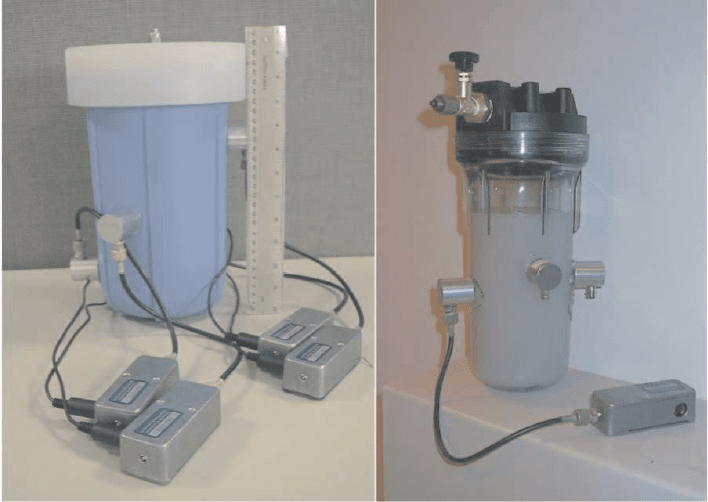
January 9, 2009 10:21 World Scientific Book - 9.75in x 6.5in ws-bo ok975x65˙n˙2nd˙Ed
722 Principles of Radiation Interaction in Matter and Detection
Fig. 10.1 A 1.5 l detector module equipped with piezoelectric sensors [Barnab´e-Heider et al.
(2002)].
ation zones near particle accelerators or reactors. These detectors can also serve
for detection of radon or be used for the measurement of the transit neutron dose
received in-flight by aviation crews, an important component of the total radiation
exposure. More details and a description of other applications can be found in [Ing,
Noulty and McLean (1997)]. For such small volumes (low gas loading), the counting
of bubbles accumulated for a period of time can be visually performed.
More recently, the PICASSO group [Barnab´e-Heider et al. (2002)] has developed
large volume detectors of the type shown in Fig. 10.1 with the aim to perform a
direct measurement of neutralinos, predicted by minimal supersymmetric models
as Cold Dark Matter (CDM) particles. The very low interaction cross section bet-
ween CDM and the detector active medium nuclei requires the use of very massive
detectors to achieve a sensitivity level, allowing the detection of CDM particles in
the galactic environment [Boukhira et al. (2000)]. Detectors of large volumes (1.5
and 3 litres) are shown in Fig. 10.1 in containers capable to hold pressures up to 10
bars. Piezo-sensors are glued on the container surface for signal detection. Typical
C
x
F
y
gas loading presently achieved for this type of detector is in the (5–10) g/litre
range.
Droplet detectors have high efficiency for detecting neutrons while being insensi-

January 9, 2009 10:21 World Scientific Book - 9.75in x 6.5in ws-bo ok975x65˙n˙2nd˙Ed
Superheated Droplet (Bubble) Detectors and CDM Search 723
tive to minimum ionizing particles (mips) and to nearly all sources of background,
when operated at proper temperature and pressure. One can observe, from ki-
nematical considerations [see Eq. (10.5), below], that nuclear recoil thresholds in
droplet detectors can be obtained in the same range for neutrons of low energy (e.g.,
from 10 keV up to a few MeV) and massive neutralinos (mass of 60 GeV/c
2
up to
1 TeV) with no sensitivity to mips and γ-radiation. Therefore, for CDM searches, the
droplet detector response to neutrons has to be fully investigated. The heavy salt,
present in the gel at production stage, contains α-emitters (U/Th and daugthers),
which are the ultimate background at normal temperature of operation. Other back-
grounds only contribute to the detector signal for higher temperatures [Boukhira
et al. (2000)]. Purification techniques are applied to remove these α-emitters [Di
Marco (2004)]. Presently, contamination levels of 10
−11
g/g for U and 10
−10
g/g for
Th are obtained, toward a final goal around 10
−14
g/g. Regardless of the level of
the purity achieved, the response of droplet detectors to α-particles has to be fully
understoo d. Recently
∗
, the PICASSO collaboration observed for the first time a
significant difference between acoustic signals induced by neutrons and α-particles
in a detector based on superheated liquids. This observation brings the possibility of
improved background suppression in CDM searches based on superheated liquids.
Sections in this chapter are devoted to neutron and α-particle response mea-
surements. These data provide an understanding of the physics mechanisms at the
base of droplet detector operation. Finally, a section is dedicated to the search for
CDM particles and, in particular, to the spin dependent part of their cross section.
10.1 The Superheated Droplet Detectors and their Operation
The response of a droplet detector to incoming particles or radiation is determined
by the thermodynamics properties of the active gas, such as operating temperature
and pressure. The detector operation can be understood in the framework of Seitz’s
theory [Seitz (1958)], in which bubble formation is triggered by a heat spike in the
superheated medium produced, when a particle deposits energy within a droplet.
The droplet should normally make a transition from the liquid phase (high po-
tential energy) to the gaseous phase (lower potential energy). However, undisturbed,
the droplet is in a metastable state, since it must overcome a potential barrier to
make the transition from the liquid to the gas phase. This transition can be achieved
if the droplet receives an extra amount of energy, such as the heat due to the energy
deposited by incoming particles. The potential barrier is given by Gibbs equation:
E
c
=
16π
3
σ(T )
3
(p
i
− p
0
)
2
, (10.1)
where the externally applied pressure, p
0
, and the vapor pressure in the bubble,
p
i
, are functions of the temperature T . The difference between these two pressures
∗
See Aubin, F. et al. (2008), Discrimination of nuclear recoils from alpha particles with super-
heated liquids, arXiv:0807.1536v1 [physics.ins-det].
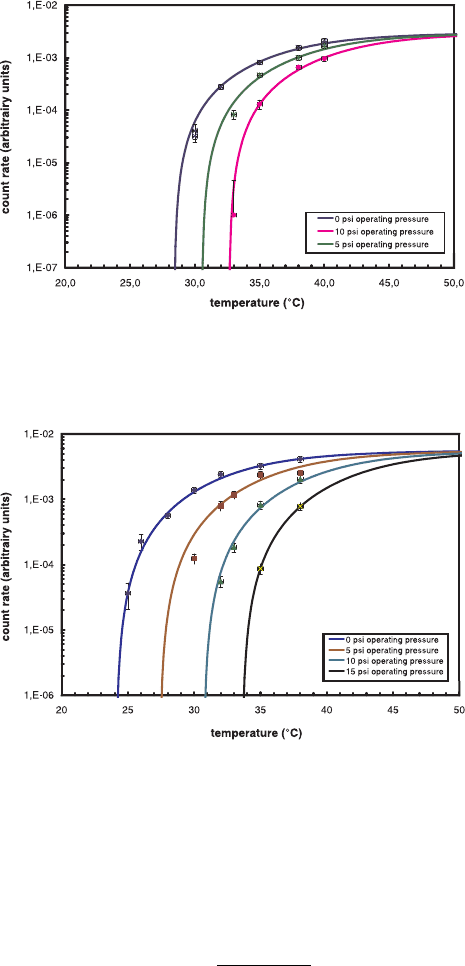
January 9, 2009 10:21 World Scientific Book - 9.75in x 6.5in ws-bo ok975x65˙n˙2nd˙Ed
724 Principles of Radiation Interaction in Matter and Detection
Fig. 10.2 Detector response to 200 keV neutrons as a function of temperature at various pres-
sures. The 8 ml detector is loaded with a 100% C
4
F
10
gas. The 200 keV neutrons used for these
measurements were obtained from
7
Li(p,n)
7
Be reactions at the tandem facility of the Universit´e
de Montr´eal [Barnab´e-Heider et al. (2002)].
Fig. 10.3 Detector response to 400 keV neutrons as a function of temperature at various pres-
sures. The 8 ml detector is loaded with a 100% C
4
F
10
gas. The 400 keV neutrons used for these
measurements were obtained from
7
Li(p,n)
7
Be reactions at the tandem facility of the Universit´e
de Montr´eal [Barnab´e-Heider et al. (2002)].
determines the degree of superheat. The surface tension of the liquid-vapor interface
at a temperature T is given by
σ(T ) =
σ
0
(T
c
− T )
(T
c
− T
0
)
,
where T
c
is the critical temperature of the gas (defined as the temperature at which
the surface tension is zero), σ
0
is the surface tension at a reference temperature T
0
(usually the boiling temp erature T
b
). For a combination of two gases, T
b
and T
c
can
be adjusted by choosing the mixture ratio. For instance T
b
= −19.2
◦
C, T
c
= 92.6
◦
C
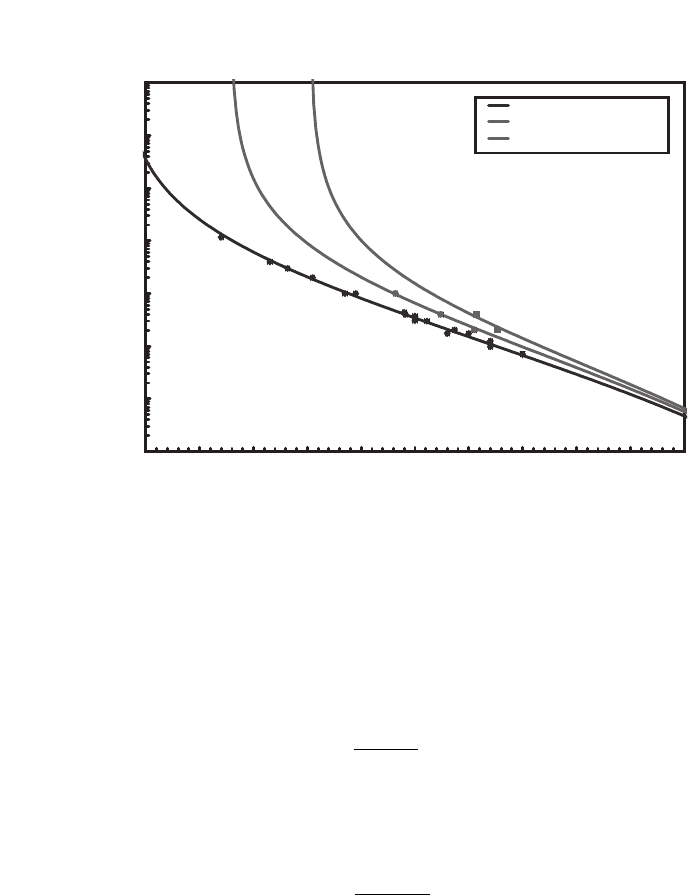
January 9, 2009 10:21 World Scientific Book - 9.75in x 6.5in ws-bo ok975x65˙n˙2nd˙Ed
Superheated Droplet (Bubble) Detectors and CDM Search 725
1
.
E+00
1
.
E+01
1
.
E+02
1
.
E+03
1
.
E+04
1
.
E+05
1
.
E+06
1
.
E+07
0
.
0
5.0
10
.
0
15
.
0
20
.
0
25
.
0
30.0
35.0
40
.
0
45
.
0
50
.
0
temperature (˚C)
n
eutrons minimal energy (keV
)
1 bar operating pressure
1
.
33 bar operating pressure
1
.
66 bar operating pressure
Fig. 10.4 Minimal neutron-energy (E
R,th
) as a function of temperature for various pressures of
operation [Barnab´e-Heider et al. (2002)].
for a detector loaded with a gas mixture; T
b
= 1.7
◦
C, T
c
= 113.0
◦
C for a detector
loaded with 100% C
4
F
10
gas [Boukhira (2002)]. Various types of droplet detectors
responses, corresponding to different gas mixtures, can be unified via their amount
of so-called reduced superheat, s, introduced in [d’Errico (1999)] and defined as
s =
T − T
b
T
c
− T
b
. (10.2)
Bubble formation will occur, when a minimum energy E
R,th
deposited, for exam-
ple, by the nuclear recoils induced by neutrons, exceeds the threshold value, E
c
,
within a distance l
c
= aR
c
, where the critical radius R
c
is given by:
R
c
=
2σ(T )
(p
i
− p
0
)
. (10.3)
A value a ≈ 2 is suggested from Apfel, Roy and Lo (1985). However, larger values
of a (up to 13) can be found in literature [Bell, Oberle, Rohsenow, Todreas and Tso
(1973)] and from recent simulation studies [Barnab´e-Heider et al. (2004)], as will be
seen below. If dE/dx is the effective energy deposition per unit distance, the energy
deposited along l
c
is
E
dep
= dE/dx × l
c
.
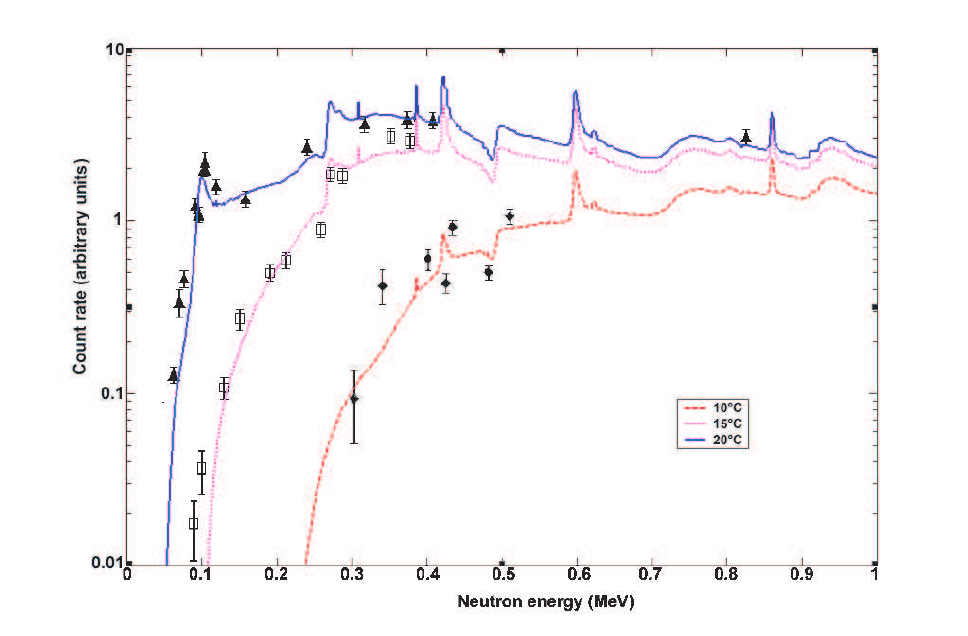
January 9, 2009 10:21 World Scientific Book - 9.75in x 6.5in ws-bo ok975x65˙n˙2nd˙Ed
726 Principles of Radiation Interaction in Matter and Detection
Fig. 10.5 Response of a droplet detector (loaded with a gas mixture) to beams of monoenergetic neutrons for different temperatures. Using the
known tabulated neutron cross section on
12
C and
19
F, the fit to the data for different temperatures gives an exponential temperature dependence
for E
i
th
(T ), and the efficiency ²
i
(E
n
, T ) is obtained with α = 1.0 ± 0.1 [Genest (2004)]. In ordinate, the count rate is in arbitrary units.

January 9, 2009 10:21 World Scientific Book - 9.75in x 6.5in ws-bo ok975x65˙n˙2nd˙Ed
Superheated Droplet (Bubble) Detectors and CDM Search 727
Note that dE/dx is a function of the energy of the nuclei recoiling after their collision
with the incident particle. The condition to trigger a liquid-to-vapor transition is
E
dep
≥ E
R,th
. Since it is not the total energy deposited that will trigger a liquid-to-
vapor transition, but the fraction of this energy transformed into heat, the actual
minimum or threshold energy E
R,th
for recoil detection is related to E
c
by an
efficiency factor
η =
E
c
E
R,th
(2 < η < 6%) [Apfel (1979); Harper and Rich (1993)]. Since the threshold energy
value depends on the temperature and pressure of operation, the detector can be set
into a regime where it mainly responds to nuclear recoils, allowing discrimination
against background radiations such as mip’s and γ-rays.
10.1.1 Neutron Response Measurement
As an example, we will consider the case of nuclear recoils induced by neutrons of low
energy (E
n
≤ 500 keV). It is possible to determine precisely the threshold energy as
a function of temperature and pressure by exposing the detector to monoenergetic
neutrons at various temperatures and pressures of operation. The detector responses
(count rates) to monoenergetic neutrons of 200 and 400 keV, measured as a function
of temperature for various pressures of operation, are shown in Figs. 10.2 and 10.3,
respectively, for a 8 ml detector.
From such curves (e.g., Figs. 10.2 and 10.3), one can extract the threshold
temperature T
th
for a given neutron energy by extrapolating the curves to their
lowest point (a few degrees below the measured lowest point). Then, it is possible
to represent the neutron threshold energy as a function of temperature for various
pressures (Fig. 10.4).
As can be seen from Fig. 10.4, for a practical range of temperature of operation,
E
R,th
follows a temperature dependence expressed as:
E
R,th
= E
b
e
−K(T −T
b
)
, (10.4)
where K is a constant to be determined experimentally and E
b
is the threshold
energy at the boiling temperature T
b
.
To understand the response of this type of detector to neutrons, one has to
study the interaction of neutrons with the nuclei (e.g.,
19
F and
12
C) of the active
material. The interactions of neutrons with the freon-like droplets (C
x
F
y
) lead to
recoils of
19
F and
12
C nuclei, inducing the phase transition. Inelastic collisions are
possible if the center-of-mass kinetic energy of the neutron–nucleus system is higher
than the first excitation level of the nucleus (1.5 and 4.3 MeV for
19
F and
12
C,
respectively). Absorption of a neutron by the nucleus followed by an ion, proton
or alpha-particle emission requires a neutron threshold energy of 2.05 MeV. The
absorption of a neutron by the nucleus may also lead to the emission of γ, but the

January 9, 2009 10:21 World Scientific Book - 9.75in x 6.5in ws-bo ok975x65˙n˙2nd˙Ed
728 Principles of Radiation Interaction in Matter and Detection
Fig. 10.6 Minimal neutron-energy as a function of the reduced superheat parameter s [Barnab´e-
Heider et al. (2002)].
droplet detectors are only sensitive to γ at high temperature of operation. In our
example, the neutron energy is lower than 500 keV. Therefore, it mainly interacts
through elastic scattering on fluor and carbon nuclei. Assuming neutron elastic
scattering on nucleus, the recoil energy E
i
R
of the nucleus i is given by:
E
i
R
=
2m
n
m
N
i
E
n
(1 − cos θ)
(m
n
+ m
N
i
)
2
, (10.5)
where E
n
is the incident neutron energy and θ is the neutron scattering angle in the
center-of-mass system; m
n
and m
N
i
are the masses of the neutron and the nucleus
i, resp ectively. The nucleus recoil energy is zero if the nucleus i recoils along the
neutron incident direction. The recoil energy of the nucleus i is maximum if θ =
180
◦
:
E
i
R,max
=
4m
n
m
N
i
E
n
(m
n
+ m
N
i
)
2
= f
i
E
n
. (10.6)
The f
i
factor is the maximal fraction of the energy of the incident neutron that
can be transmitted to the nucleus i: f
i
= 0.19 and 0.28 for
19
F and
12
C, respecti-
vely. The ranges for
19
F and
12
C depend on the value of E
R,max
[Eq. (10.6)] and
on their specific energy-losses dE/dx, which can be calculated using TRIM, a code
calculating the transport of ions in matter [Ziegler and Biersack (2000)].
At a given neutron energy E
n
, the recoiling nuclei i (i =
19
F,
12
C) are emitted
with an angular distribution: every angle is associated with a specific recoil energy,
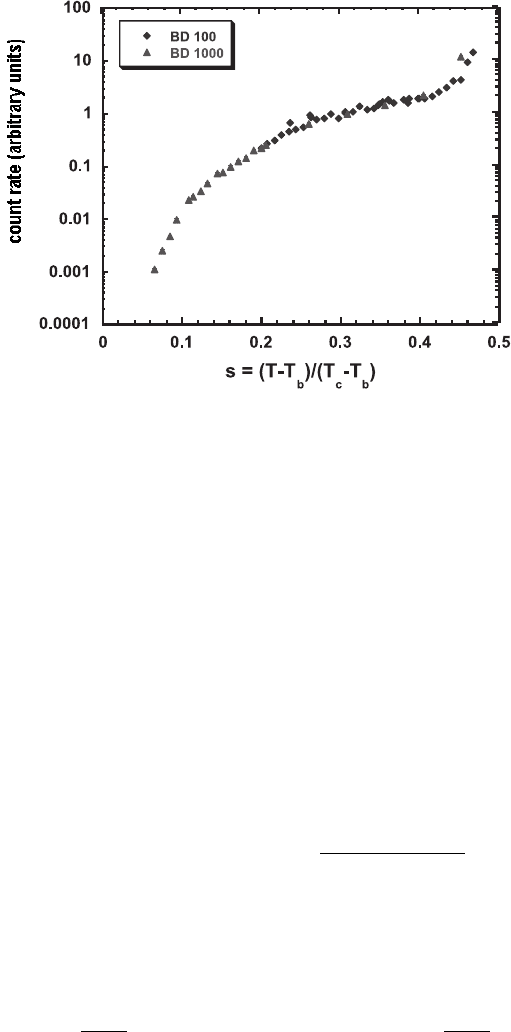
January 9, 2009 10:21 World Scientific Book - 9.75in x 6.5in ws-bo ok975x65˙n˙2nd˙Ed
Superheated Droplet (Bubble) Detectors and CDM Search 729
Fig. 10.7 The response of two detectors one called BD100 (loaded with a gas mixture) and the
other called BD1000 (loaded with 100% C
4
F
10
) to neutrons from an AcBe source as a function
of reduced superheat s. The use of the reduced superheat parameter allows the unification of the
response of the two detectors. With parameter s, the response for different gases is computed with
T
c,eff
= 0.9 T
c
[Barnab´e-Heider et al. (2002)].
ranging between 0 keV up to a maximum energy E
i
R,max
. Therefore, the nucleus re-
coil energy distribution, dn
i
/dE
i
R
, is determined by the
19
F and
12
C recoil angular
distributions. Not all recoil energy depositions are detectable, since there exists a
threshold recoil energy, E
i
R,th
, below which no phase transition is triggered. E
i
R,th
depends on the temperature and pressure of operation and is related to the neutron
energy threshold, E
i
th
, by the relation E
i
R,th
= f
i
E
i
th
. The threshold energy has
an exponential dependence on temperature [Eq. (10.4) and Fig. 10.4]. The proba-
bility, P(E
i
R
,E
i
R,th
(T )), that a recoiling nucleus i at an energy near threshold will
generate an explosive droplet-to-bubble transition is zero for E
i
R
< E
i
R,th
and will
increase gradually up to 1 for E
i
R
> E
i
R,th
. This probability can be expressed as:
P (E
i
R
, E
i
R,th
(T )) = 1 − exp
·
−α
E
i
R
− E
i
R,th
(T )
E
i
R,th
(T )
¸
, (10.7)
where α is a parameter to be determined experimentally. Therefore, the efficiency
²
i
(E
n
, T ), that a i -type recoil nucleus triggers a droplet-to-bubble phase transition
at a temperature T after being hit by a neutron of energy E
n
, is given by comparing
the integrated recoil spectrum with and without threshold:
²
i
(E
n
, T )=
Z
E
i
R,max
E
i
R,min
dn
i
dE
i
R
P (E
i
R
, E
i
R,th
(T )) dE
i
R
,
Z
E
i
R,max
0
dn
i
dE
i
R
dE
i
R
. (10.8)
For neutrons of energy lower than 500 keV, collisions with
19
F and
12
C are elastic
